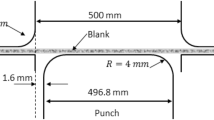Abstract
With an increasing demand to reduce the body weight of motor vehicles, advanced high strength steel (AHSS) is widely applied in the automobile industry. However, high residual stresses and redundant deformation caused by the cold roll forming process are still outstanding problems. Under such circumstances, Chain-die forming technology is developed. Through enlargement of the effective roll radius, the deformation length is significantly stretched, leading to a significant reduction in residual stresses and redundant strain. In this study, Chain-die formed AHSS U-channel products are investigated experimentally and numerically. The influences of a number of features such as material strength, sheet metal thickness, vertical forming gap, and effective virtual roll radius are discussed regarding average flange angle and the variation of flange angle along the longitudinal direction. The results show that the average flange angle decreases with the increase of material strength, vertical forming gap, and effective virtual roll radius. Furthermore, among all four controllable variables, effective virtual roll radius has the most significant impact on the variation of the flange angle along the longitudinal direction.
Similar content being viewed by others
References
Halmos GT (2005) Roll forming handbook. CRC Press
Tehrani MS, Hartley P, Naeini HM, Khademizadeh H (2006) Localised edge buckling in cold roll-forming of symmetric channel section. Thin-Walled Struct 44(2):184–196. doi:10.1016/j.tws.2006.01.008
Wiebenga J, Weiss M, Rolfe B, Van Den Boogaard A (2013) Product defect compensation by robust optimization of a cold roll forming process. J Mater Process Technol 213(6):978–986. doi:10.1016/j.jmatprotec.2013.01.006
Ding S, Daniel W, Yuan J, Zhang Y (2008) Making roll forming flexible-introduction to Chain forming. In: Yokohama Tube and Pipe 2011 Joint Symposium-Innovative Tube and Pipe Manufacturing and Forming. Curran Associates Inc, pp 335–340
Groche P, Beiter P, Henkelmann M (2008) Prediction and inline compensation of springback in roll forming of high and ultra-high strength steels. Prod Eng 2(4):401–407. doi:10.1007/s11740-008-0131-3
Lee E-M, Shim D-S, Son J-Y, Baek G-Y, Yoon H-S, Ro K-B (2016) Study on design of progressive dies for manufacture of automobile structural member using DP980 advanced high strength steel. J Mech Sci Technol 30(2):853–864. doi:10.1007/s12206-016-0140-7
Albut A (2008) The influence of the sheet thickness on springback effect in case of TWB’s forming. Communication and Information Technology, Circuits System and Signals, Applied Mathematics, Simulation Modeling, June 13:147–150
Thipprakmas S, Phanitwong W (2011) Process parameter design of spring-back and spring-go in V-bending process using Taguchi technique. Mater Design 32(8–9):4430–4436. doi:10.1016/j.matdes.2011.03.069
Lindgren M (2007) Cold roll forming of a U-channel made of high strength steel. J Mater Process Technol 186(1–3):77–81. doi:10.1016/j.jmatprotec.2006.12.017
Paralikas J, Salonitis K, Chryssolouris G (2009) Investigation of the effects of main roll-forming process parameters on quality for a V-section profile from AHSS. Int J Adv Manuf Technol 44(3–4):223–237. doi:10.1007/s00170-008-1822-9
Safdarian R, Naeini HM (2015) The effects of forming parameters on the cold roll forming of channel section. Thin-Walled Struct 92:130–136. doi:10.1016/j.tws.2015.03.002
Sheu JJ (2004) Simulation and optimization of the cold roll-forming process. In: Materials processing and design: modeling, simulation and applications-NUMIFORM 2004-Proceedings of the 8th International Conference on Numerical Methods in Industrial Forming Processes, vol 1. AIP Publishing, pp 452–457. doi:10.1063/1.1766566
Ding SC, Zhang YK (2012) Chain-die Forming, is it a right forming method to make structural parts of motor vehicles with UHSS material. Paper presented at the International Conference on Advanced Vehicle Technologies and Integration
Zhang YK, Ding SC (2012) Experimental study on Chain-die forming for ultrahigh strength steel (UHSS). Paper presented at the 15th International Conference on Advances in Materials & Processing Technologies
Yong S, Yaguang L, Kun Z, Fei H, Zhaobing L, WJT D, Dayong L, Lei S, Shichao D (2015) The experimental investigation on Chain-die forming U-profiled AHSS products. In: 10th CSM Steel Congress and the 6th Baosteel Biennial Academic Conference, shanghai, China
Zhang YK, Ding SC (2012) A comparison study of Chain-die forming and roll forming by forming a top hat section. Paper presented at the 14th International Conference on Metal Forming, Germany: Akademia Górniczo-Hutnicza in Kraków
Author information
Authors and Affiliations
Corresponding author
Rights and permissions
About this article
Cite this article
Qian, Z., Sun, Y., Meehan, P.A. et al. Experimental and numerical investigation of flange angle in Chain-die formed AHSS U-channel sections. Int J Adv Manuf Technol 92, 1231–1242 (2017). https://doi.org/10.1007/s00170-017-0159-7
Received:
Accepted:
Published:
Issue Date:
DOI: https://doi.org/10.1007/s00170-017-0159-7



